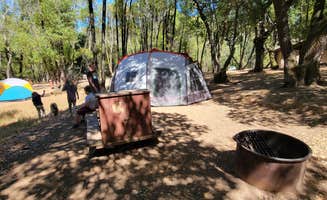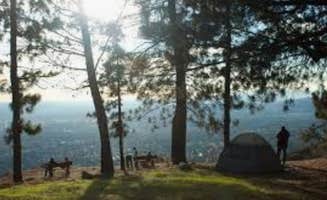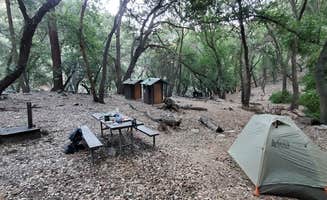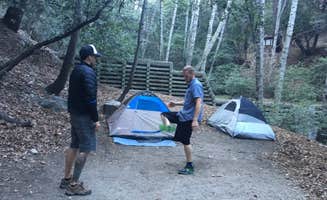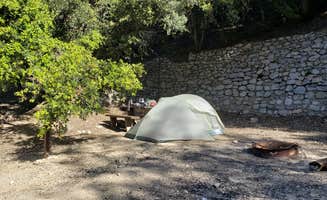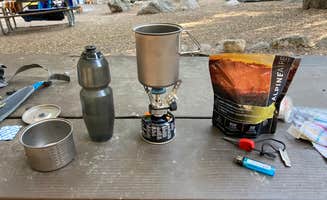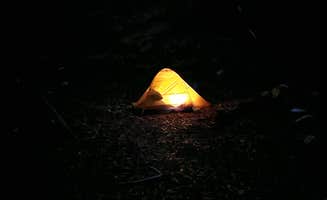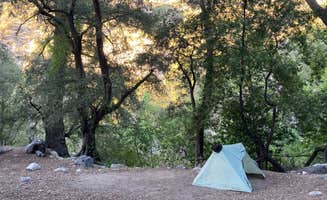Tent camping near Santa Ana offers a mix of secluded trailside camps and backpacking destinations within an hour's drive. Many backcountry sites in the region sit at elevations between 2,000-7,000 feet, providing significantly cooler temperatures than Santa Ana's urban heat. During winter months, mountain camps may experience nighttime temperatures below freezing, while lower elevation sites remain accessible year-round with minimal seasonal restrictions.
What to do
Creek exploration: Millard Trail Campground offers excellent opportunities for stream exploration. "This walk-in campground is part of China Camp State Park. Only 33 tent-only sites! Wheeled totes can be borrowed to haul your gear up some little hills to your campsite under oak and bay trees," writes Laura F., describing the nearby China Camp State Park Campground. The stream access provides natural cooling during summer months.
Mountain biking: Mt. Wilson trails provide extensive riding opportunities for campers. "Located on the west side of the San Rafael/Richmond Bridge, on San Francisco Bay, this park is extremely popular with mountain bikers," notes Nathaniel S. Many trails connect directly to tent camping areas, allowing for multi-day riding excursions with overnight camping.
Stargazing: Angeles Forest sites offer minimal light pollution. "It was eerily quiet at night. We were the only ones there and can hear our own hearbeats laying there at night," shares Stacy C. about Mount Lowe Trail Campground. Many backcountry sites provide unobstructed night sky viewing with the Milky Way visible during new moon phases.
What campers like
Wildlife watching: Dawn and dusk offer prime animal sighting opportunities. "We had deer walking directly through our site as we were eating dinner. They didn't bother anyone and were really cool to watch," notes Corey B. about camping at Two Harbors Campground. Sites near water sources tend to have more wildlife activity.
Accessible backpacking: Short trails make wilderness camping attainable for beginners. "Took some friends for their first ever backpacking trip, great intro to the 'experience.' Trail camp is in the canyon so it's an easy 3.5 mile hike in, but a tough hike out of the canyon," writes Kelly B. about Valley Forge Trail Camp. The modest elevation gain makes these sites suitable for novice backpackers.
Isolation: Midweek camping provides the most solitude. "Very peaceful midweek," notes Laura F. Most backcountry sites receive minimal visitor traffic Monday through Thursday, with significant increases on weekends. Some sites remain completely empty on non-holiday weekdays.
What you should know
Fire restrictions: Seasonal bans affect most tent sites. "Check on camp fires permitted (last time I was there ABSOLUTELY NO FIRES ALLOWED)," warns Tom P. about Mount Lowe. Fire regulations change based on conditions, with most sites prohibiting open flames during late summer and fall.
Water availability: Filter required for most creek water sources. "We filtered water from the West Fork San Gabriel River that seems more like a creek," explains CodyRay C. about Valley Forge Trail Camp. Water sources may diminish or disappear during late summer and fall months.
Wildlife concerns: Food storage essential at all sites. "The raccoons here are AGGRESSIVE! They won't attack you, but they will walk right up to your camp and try to steal your food," cautions Rosie C. Most sites provide food storage boxes, but smaller animals remain persistent.
Tips for camping with families
Site selection: Choose established campgrounds for first-time family trips. "I am camping with my husband and 3 kids and our puppy. The hosts are friendly, cheap firewood, china beach village is just down the road and perfect to explore and swim," shares Veronica H. about her experience at China Camp State Park.
Trail difficulty: Valley Forge access suits younger hikers. "Forage your way through the Valley Forge Trail, for an intimate night in the wilderness at one of its remote camps," suggests David F. The gradual incline makes this trail manageable for families with school-age children.
Safety precautions: Weather preparation critical for mountain sites. "The park itself is classic country California - oak, madrone, and even the occasional redwood. It's often foggy in the morning, and sunny in the afternoon," notes Nathaniel S. Temperature swings of 30+ degrees between day and night occur frequently, requiring proper clothing and sleeping gear.
Tips for RVers
Access limitations: Most tent sites prohibit vehicle access. "The sites are pretty expensive and charge by the person. $27-$29 (Winter-Summer pricing) for each person with a $10 reservation fee," explains Hayley K. about Two Harbors Campground. Many trailhead parking areas have size restrictions for vehicles.
Gear transport: Trail camps require carrying equipment. "You won't be able to drive up to your campsite. You have to carry your gear in a short distance from the parking lot," explains Rosie C. Distances from parking to campsites range from 100 yards to several miles.
Overnight parking: Adventure Pass required at most trailheads. "Lots of parking at the bridge but make sure you have an adventure pass," advises Tom P. about Glenn Trail Camp Campground. Day-use areas generally prohibit overnight parking without proper permits.


